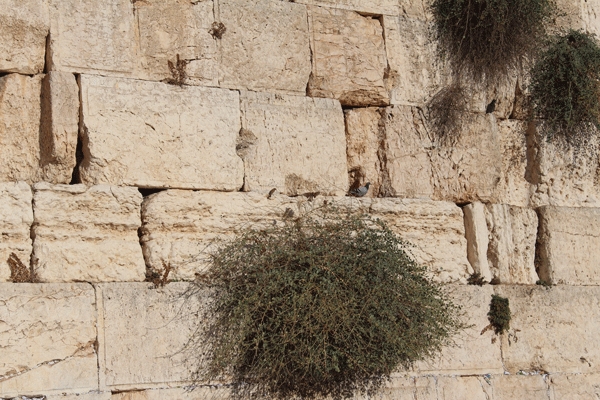Whilst in the midst of this thought, something suddenly caught my eye. There are a number of bushes growing out of the Kosel. Some of them are small and some are large, but all of them are the same species, the tzlaf plant (caper bushes) mentioned in Gemara Brachos (36a). These plants also piqued my curiosity. What are all of these caper bushes doing at the Kosel?
THE FOUR PARTS OF THE CAPER BUSH
Chazal tell us that in addition to its flower, the tzlaf plant has a number of edible parts. The bud of the tzlaf, from which the flowers grow, is called kafrisin. These buds are sold today in a pickled form as caper berries. The Gemara mentions a machlokes as to whether the bracha on these berries is ha’adamah or ha’eitz.
When the buds open, they produce a beautiful flower. The flower has a petal in the middle with the beginning of a fruit on the end. As the flower withers, the main fruit of the tzlaf, the evyonos, grows and develops.
When the evyonos reach fruition, they are about the size of a very large olive. This fruit has a thick green peel and sweet yellow fruit inside. Since this is the main fruit of the tzlaf, the bracha on it is ha’eitz.
The Gemara adds that the leaves of the tzlaf are also edible. These are called alim and their bracha is ha’adamah.
There is one more fruit called the tamaros. All in all, there are four fruit on the tzlaf.
The Birkei Yosef (202:5) notes that today, the bracha on the kafrisin is ha’eitz, sincethese caper berries are the main fruit. As these fruit are the beginning of the flower, they have a beautiful scent. When they are pickled, they have a delicious taste and are sold as caper berries.
TASTE AND AROMA
In order to understand the message of the caper bush, we must first understand the deeper meaning of the Daled Minim. Chazal tell us that the lulav, whose fruit has a taste but not an aroma, is compared to the Jew who is strong in Torah but lacking in mitzvos. A person who excels in mitzvos but is weak in Torah is compared to a hadas, which has a fragrance but doesn’t produce fruit.
An esrog has aroma and taste and is compared to the Jew who is strong in Torah and mitzvos.
The aravah, which has neither taste nor aroma, is compared to the simple Jew who is not strong in Torah or mitzvos. Chazal’s comparison of the Daled Minim begs the question: Why did Chazal equate learning Torah with the sense of taste and performing mitzvos with the sense of smell?
Food that tastes good but that has no aroma is pleasurable to the person eating it, but it gives no pleasure to those sitting near him. Food that smells delicious but is tasteless gives both the person eating it and those around him pleasure from the aroma, but no one experiences the entire pleasure of eating the food.
Correspondingly, a Jew who learns Torah but who does not actively involve himself with mitzvos may feel tremendous self-gratification, but others cannot feel the direct benefit of his toil. Similarly, someone who is fervently involved with mitzvos but does not learn Torah may help many people, but he is missing the true taste of Divine service. Only the exceptional individual who synthesizes both Torah and mitzvos can be considered a complete Jew.
THE FOUR PARTS OF THE CAPER BUSH
While the kafrisin have scent and taste, the main fruit, the evyonos, have a pleasant taste, but do not have a fragrance. The flowers have a fragrance, but they cannot be consumed. The leaves have little taste or smell, but they are nonetheless consumed.
In summation, these four parts of the caper bush have parts with scent and taste, scent and no taste, taste and no scent, and no scent or taste. All in all, the tzlaf has all four attributes of the Daled Minim. Yet, while the lulav and esrog come from four different plants, the tzlaf has all of these attributes in one plant.
When looking at all the different Jews davening in front of the tzlaf bushes growing out of the Kosel, it suddenly occurred to me that Hashem is sending us a powerful message: There are many different types of Jews who attend the tefillos at the Kosel, some who might not necessarily see eye to eye. Yet, the goal of the Bais Hamikdosh is to bring all Jews together as one and to unite Klal Yisroel under the banner of Hashem.
The next time you go to the Kosel and see someone with whose hashkafah you might not agree, take a quick peek at the Kosel and look at the tzlaf plant. If you listen carefully to what this bush is saying, you will hear the following message that Hashem is sending to us: “Unite My children and make peace amongst yourselves. Do not hate any Jew, for you are all brothers. I am waiting to return to My home in Yerushalayim and there is only one thing stopping me. All Jews are meant to care about each other and be united through Torah and mitzvos.”








